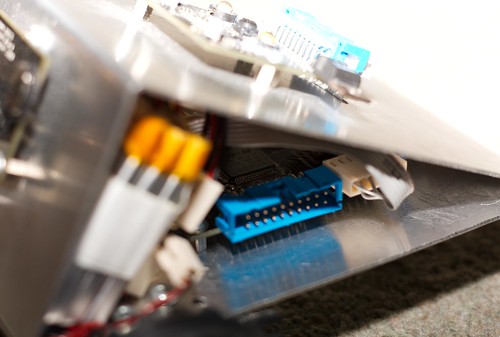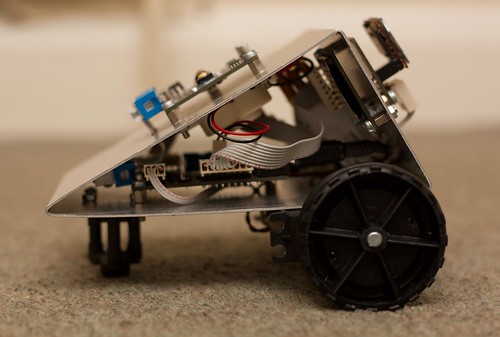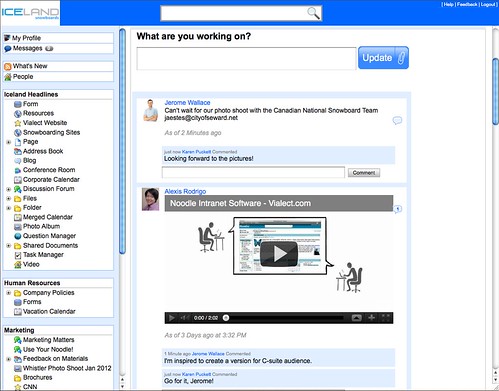Robot 2
Image by Randomskk
I think the hardware is pretty much all assembled now! The batteries went together today and now connect up to everything, although I may mount them a bit more permanently in the future. The buzzer's held on with tape but it's light weight and protected by the case; everything else is bolted on.
This robot will use its camera to track the user, following them around and taking photos to store to the SD card. The software's progressing nicely enough - at the moment I can clearly see what's on the screen, but it's only a small fraction of the total image and the colours are not yet accurate. The chip doesn't have enough RAM to hold the entire image on the screen at once unfortunately, but I should be able to process each line before the next one comes in.
The robot uses an ARM Cortex-M3 STM32F103VBT6 microprocessor with a TCM8230MD camera from SparkFun, an OLED screen module on the back (also from SparkFun) with a navigation switch, modified servos for motors, various voltage regulators for the camera and main circuitry, a ball bearing caster on the bottom, a piezo buzzer to make it beep at you, three 1100mAh lithium polymer batteries (one for the main systems and two in series for the servos), PCBs made by Golden Phoenix in China and some standard power LEDs as headlights.
Robot 2
Image by Randomskk
I think the hardware is pretty much all assembled now! The batteries went together today and now connect up to everything, although I may mount them a bit more permanently in the future. The buzzer's held on with tape but it's light weight and protected by the case; everything else is bolted on.
This robot will use its camera to track the user, following them around and taking photos to store to the SD card. The software's progressing nicely enough - at the moment I can clearly see what's on the screen, but it's only a small fraction of the total image and the colours are not yet accurate. The chip doesn't have enough RAM to hold the entire image on the screen at once unfortunately, but I should be able to process each line before the next one comes in.
The robot uses an ARM Cortex-M3 STM32F103VBT6 microprocessor with a TCM8230MD camera from SparkFun, an OLED screen module on the back (also from SparkFun) with a navigation switch, modified servos for motors, various voltage regulators for the camera and main circuitry, a ball bearing caster on the bottom, a piezo buzzer to make it beep at you, three 1100mAh lithium polymer batteries (one for the main systems and two in series for the servos), PCBs made by Golden Phoenix in China and some standard power LEDs as headlights.
Robot 2
Image by Randomskk
I think the hardware is pretty much all assembled now! The batteries went together today and now connect up to everything, although I may mount them a bit more permanently in the future. The buzzer's held on with tape but it's light weight and protected by the case; everything else is bolted on.
This robot will use its camera to track the user, following them around and taking photos to store to the SD card. The software's progressing nicely enough - at the moment I can clearly see what's on the screen, but it's only a small fraction of the total image and the colours are not yet accurate. The chip doesn't have enough RAM to hold the entire image on the screen at once unfortunately, but I should be able to process each line before the next one comes in.
The robot uses an ARM Cortex-M3 STM32F103VBT6 microprocessor with a TCM8230MD camera from SparkFun, an OLED screen module on the back (also from SparkFun) with a navigation switch, modified servos for motors, various voltage regulators for the camera and main circuitry, a ball bearing caster on the bottom, a piezo buzzer to make it beep at you, three 1100mAh lithium polymer batteries (one for the main systems and two in series for the servos), PCBs made by Golden Phoenix in China and some standard power LEDs as headlights.
Microblogging in Noodle Intranet - Vialect.com
Image by Noodle Intranet
Twitter-like microblogging is the one of the most popular features of intranet software, Noodle.
Let others know what you're working on, ask for help, comments or suggestions, or share something interesting, funny or even disturbing with your co-workers. Your status update can include hyperlinks as well as embedded photos and videos.
Watch this video to see how microblogging works in Noodle intranet.
Or click here for a free trial of Noodle intranet software (no credit card required).
Noodle is the social intranet software that improves communication, enhances collaboration, and encourages innovation in the enterprise. It brings microblogging, wikis, document sharing, instant messaging and other social business tools in a single portal. Click here to see what's possible with Noodle.
Preparing for Chrismas
Image by Harshad Sharma
Yay! Christmas is almost here!
By the way, do you notice thee greeting cards in the center? The photographs (on three of them) and designing is mine :D We printed six thousand greeting cards and sold them as charity for the Dnyanodaya Magazine (A Christian Monthly).
This magazine is the oldest Marathi Monthly in India. The only older publication is the Times of India ;-) I'm proud to be a part of the team that runs the 164 year old magazine.
Anyway, more than the decorations and social gatherings, I am eager to celebrate another day dedicated to my Saviour :)
...must live a better life...
(I hope that excludes working through the night on new software!)
No comments:
Post a Comment